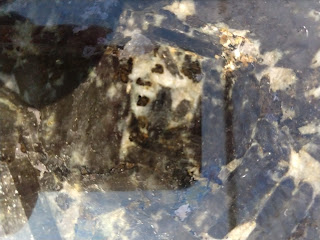Metamorphic Construction Materials
I live in mine company housing and it is not fancy. The upgrades you'd find in a nice house won't been seen here. But I have a few pieces of granite from a mineral show that I use as a coaster. Nice right?
This piece interest me because of the way the grains are shaped. The reflection makes it difficult to see well, sorry
What makes me wonder about it is the direction the minerals. They seem to be going in all different directions. Is it relevant?
In the book minerals are shown as facing the same direction, or at least described as mostly the same direction.
The shape of some of the minerals in this rock are platy and others are needle-like. As seen in this image from chapter 7 of the book.
When the rock was metamorphosed it would have changed the shape and texture of the coarse minerals. The look of it makes me wonder if it was simply compressed.
Truth is, I am not sure how to identify a rock that is not in fact marble but is something else. What do you think? It his one marble? How can you tell?
This rock is another marble that I am pretty sure is marble. It has small reflective minerals inside with an even, smooth structure. It almost looks painted to me in this picture.
I believe it was simply compressed. There is no evidence of shearing, any kind of partial melting, or contacts in this sample that would indicate it is another kind of rock. It seems pretty straight forward to me.
My lovely sister sent me some pictures of her kitchen. The marble is nice because she can stick her hot pans right on it. Marble was formed and became equalized at hotter temperatures. Perhaps that is why it doesn't warp or discolor with the heat from a baking sheet?
Non-foliated rocks are named based on their composition. Limestone and dolomite make marble. In this sample the black and possibly the orange look to be from dolomite. Is that right?







Comments
Post a Comment